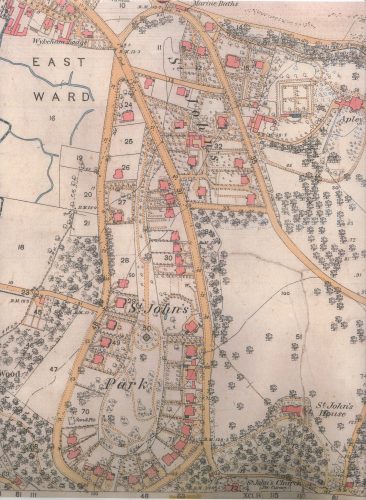St John’s Park
The landscaping of the Park 1858
Situated between what we now know as East Hill and West Hill roads, this suburb to the town of Ryde formed the chief piece of landscape gardening in the neighbourhood; and considering the period within which it was designed and laid out, the umbrageous foliage of exotic and indigenous flowering and evergreen trees and shrubs that it presented, must be conclusive testimony of the congenial climate by which it was surrounded, and the healthiness of the soil upon which it rested.
Its commanding situation had, we perceive, not been overlooked, as nearly every building plot had been taken, and there were now erected, or in the course of erection upon it, above a dozen magnificent mansions or cottage ornees, which were equal for size and elegance of any already existing in the neighbourhood. The spacious and elegant lawns and parterres of the park would be accessible to the whole of the inhabitants occupying the residences by which it was surrounded. In the centre of the grounds there was a spacious summer house of a rustic style, in keeping with the whole design, on the south front of which there was an archery ground.
The main entrance, near the Strand, was an imposing structure, consisting of nine massive pillars of Caen stone, the central one being richly carved, with the Simeon arms in a niche; and all the others were more or less relieved by the aid of the chisel. The pillars were connected with an elegant iron palisade and iron gates to match, and the whole work gave stateliness and importance to the original design. There was also a minor entrance from St. John’s Road, opposite the summer house, of a similar style of architecture, the plans of which emanated from Mr. Hellyer, of Melville-street, and the carving was done by Mr. Baker, the eminent sculptor.
It was understood that it was intended to construct a road from the centre of the park on the west side, to meet the road near the gas works, which would open an excellent and much-desired communication between the top and central parts of Ryde and the eastern suburbs. It was informed by a Commissioner that Sir John Simeon had offered a large portion of the marsh land to the body of Commissioners at agricultural price for the purpose of public recreation,–it was chronicled that the settlement of the splendid offer would not be lost.
Sources: IW Observer & RSHG Archive
Image: Map 1862 IW Record Office
Article: Ann Barrett

